
Helianthus is a genus comprising about 70 species of annual and perennial flowering plants in the daisy family Asteraceae commonly known as sunflowers. Except for three South American species, the species of Helianthus are native to North America and Central America. The best-known species is the common sunflower. This and other species, notably Jerusalem artichoke, are cultivated in temperate regions and some tropical regions, as food crops for humans, cattle, and poultry, and as ornamental plants. The species H. annuus typically grows during the summer and into early fall, with the peak growth season being mid-summer.

Tiarella, the foamflowers, is a genus of flowering plants in the family Saxifragaceae. The generic name Tiarella means "little turban", which suggests the shape of the seed capsules. Worldwide there are seven species, one each in eastern Asia and western North America, plus five species in eastern North America. As of October 2022, the taxonomy of Tiarella in eastern North America is in flux.

Cunila origanoides, with the common names stone mint, frost mint, dittany, and American dittany, is a perennial late-summer-flowering subshrub with small purple flowers that is native to the central and eastern United States. It belongs to the Lamiaceae (mint) family and is the only species in the Cunila genus native to the United States. It grows in habitats such as dry forests and the thin soil around rock outcrops. This species has historically been cultivated for use as a medicinal herb, tea, and ornamental plant.

Sabatia angularis, commonly called rosepink, rose pink, square-stem rose pink or rose gentain is a biennial flowering plant in the Gentianaceae (gentain) family. It is native to central and eastern North America.
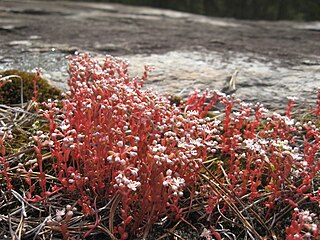
Diamorpha is a genus of plants in the family Crassulaceae. It is sometimes included within the genus Sedum. It is monotypic, including only the species Diamorpha smallii, an endemic of the southeastern United States. It becomes active in late fall and winter, blooms in late March, then dies. It has red succulent leaves that act to reflect light and hold water. Diamorpha smallii is found primarily on solution pools, shallow basins on rocky outcrops that contain seasonal pools. The plant is mainly found in Georgia, though populations have also been noted in Alabama, South Carolina, North Carolina, Tennessee, and Virginia. It is listed as an endangered species by the Tennessee Department of Environment and Conservation.

Trillium sulcatum is a species of flowering plant in the bunchflower family Melanthiaceae. It is a member of the Erectum group, a group of species typified by Trillium erectum. The specific name sulcatum means "furrowed, grooved, or sulcate", which describes the tips of the sepals. It is most abundant on the Cumberland Plateau in central Tennessee and eastern Kentucky where it blooms in April and May. The species is commonly known as the southern red trillium or furrowed wakerobin.
Penstemon personatus is an uncommon species of penstemon known by the common name closethroat beardtongue.

Penstemon grandiflorus, known by the common names shell-leaved penstemon, shell-leaf beardtongue, or large-flowered penstemon, is a tall and showy plant in the Penstemon genus from the plains of North America. Due to its large flowers it has found a place in gardens, particularly ones aimed at low water usage like xeriscape gardens.
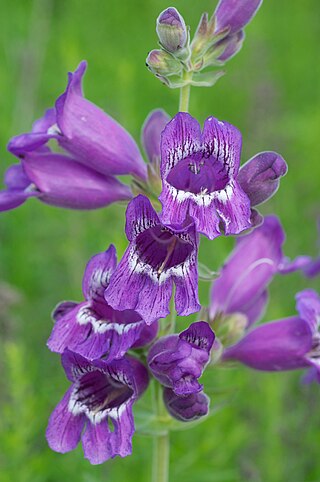
Penstemon cobaea is a flowering plant in the plantain family, commonly known as cobaea beardtongue, prairie beardtongue or foxglove penstemon. The plant is native to the central United States, primarily the Great Plains from Nebraska to Texas, with additional populations in the Ozarks of Missouri and Arkansas. There are also populations reported in the southwestern United States as well as in Illinois and Ohio, but these appear to be introductions.
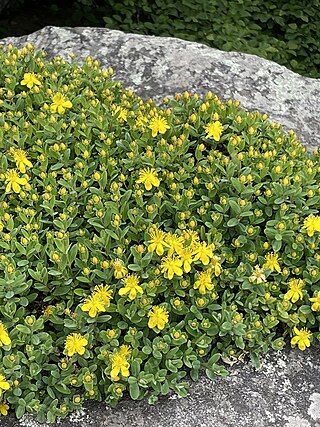
Hypericum buckleyi, known as Blue Ride St. John's wort and Buckley's St. Johnswort, is a rare species of flowering plant in the family Hypericaceae found only in the Appalachian Mountains of the southeastern United States. The species is listed in the state of Georgia (S1), South Carolina (SX), and North Carolina (S3).

Agalinis gattingeri, the roundstem false foxglove, is an annual hemiparasitic forb measuring between 10.5 and 60.5 cm in height.
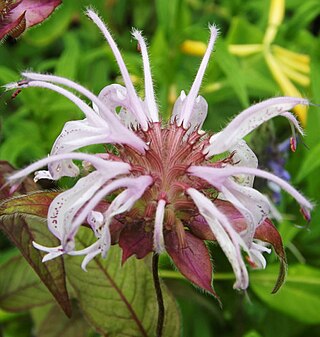
Monarda bradburiana, the eastern beebalm or Bradbury's beebalm, is a species of perennial flowering plant in the mint family, Lamiaceae, that is native to much of the southeastern United States.

Hydrophyllum appendiculatum, commonly known as great waterleaf, appendage waterleaf, or woolen breeches, is a species of plant in the Boraginaceae (borage) family. It is native to central and eastern North America where it is found primarily in the Midwest and Upper South of the United States. It is a biennial that produces lavender-colored flowers in late spring and early summer.

Penstemon tenuis is a species of flowering plant in the plantain family known by the common name sharpsepal beardtongue. It is endemic to Texas, Louisiana, Mississippi, and Arkansas in the United States where it is found in open, damp areas in alluvial soil. It flowers from early April into early June.

Carex appalachica, the Appalachian sedge, is a species of flowering plant in the family Cyperaceae, native to eastern temperate forests of the United States and Canada. The plant is wide-ranging in the American Northeast and Southern Canada while in the southern reaches of their range they are generally restricted to high elevations. A member of the large genus Carex, commonly known as sedges, this species is a member of the Carex rosea complex within the subgenus Vignea.
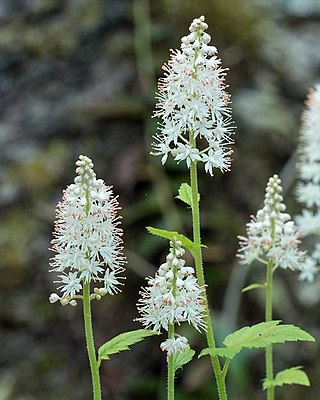
Tiarella austrina is a species of flowering plant in the family Saxifragaceae. The specific name austrina means "from the south". Being endemic to the southeastern United States, it is sometimes referred to as the southern foamflower. It is one of two species of Tiarella that spread by stolons.

Penstemon whippleanus, commonly known as dusky penstemon, dusky beardtongue, Whipple's penstemon, or Whipple's beardtongue, is a summer blooming perennial flower in the large Penstemon genus. It is a widespread plant within the hemiboreal forests of the Rocky Mountains in North America. It is noted for the large deep purple-red flowers and a preference for high mountain elevations.

Penstemon secundiflorus, commonly known as sidebells penstemon, or orchid beardtoungue is a species of Penstemon that grows in dry forests, high plains, and scrub lands from Wyoming to Mexico. It is a herbaceous perennial plant that typically grows to a height of 20 to 50 cm and has narrow, lance-shaped leaves that are grayish-green in color. The flowers of the sidebells penstemon are tubular in shape and are arranged in a one-sided spike, with the blooms all facing the same direction, and for this reason was named "secundiflorus", which means "one-sided flowers". The flowers are most often delicate shades of orchid or lavender. It is sometimes used in xeriscaping, rock gardens, and wildflower meadows, and is well-suited to dry, sunny locations with well-drained soil.

Penstemon auriberbis, commonly known as the Colorado penstemon or Colorado beardtongue, is a species of Penstemon that grows in the shortgrass prairies of southern Colorado and in a few places in northern New Mexico. Although specimens were collected on the 1820 expedition by Stephen H. Long through the area, they were not scientifically described as a separate species until 1920.
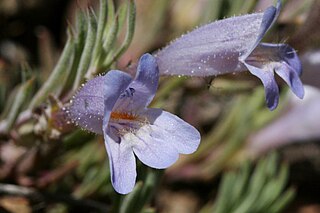
Penstemon caespitosus, commonly known as mat penstemon, is a summer blooming perennial flower in the large Penstemon genus. It is a widespread plant from near timberline to the foothills in the Southern Rocky Mountains and Colorado Plateau in North America. It is noted for its ground hugging growth habit and as a plant used in xeriscape and rock gardening.




















